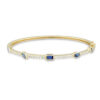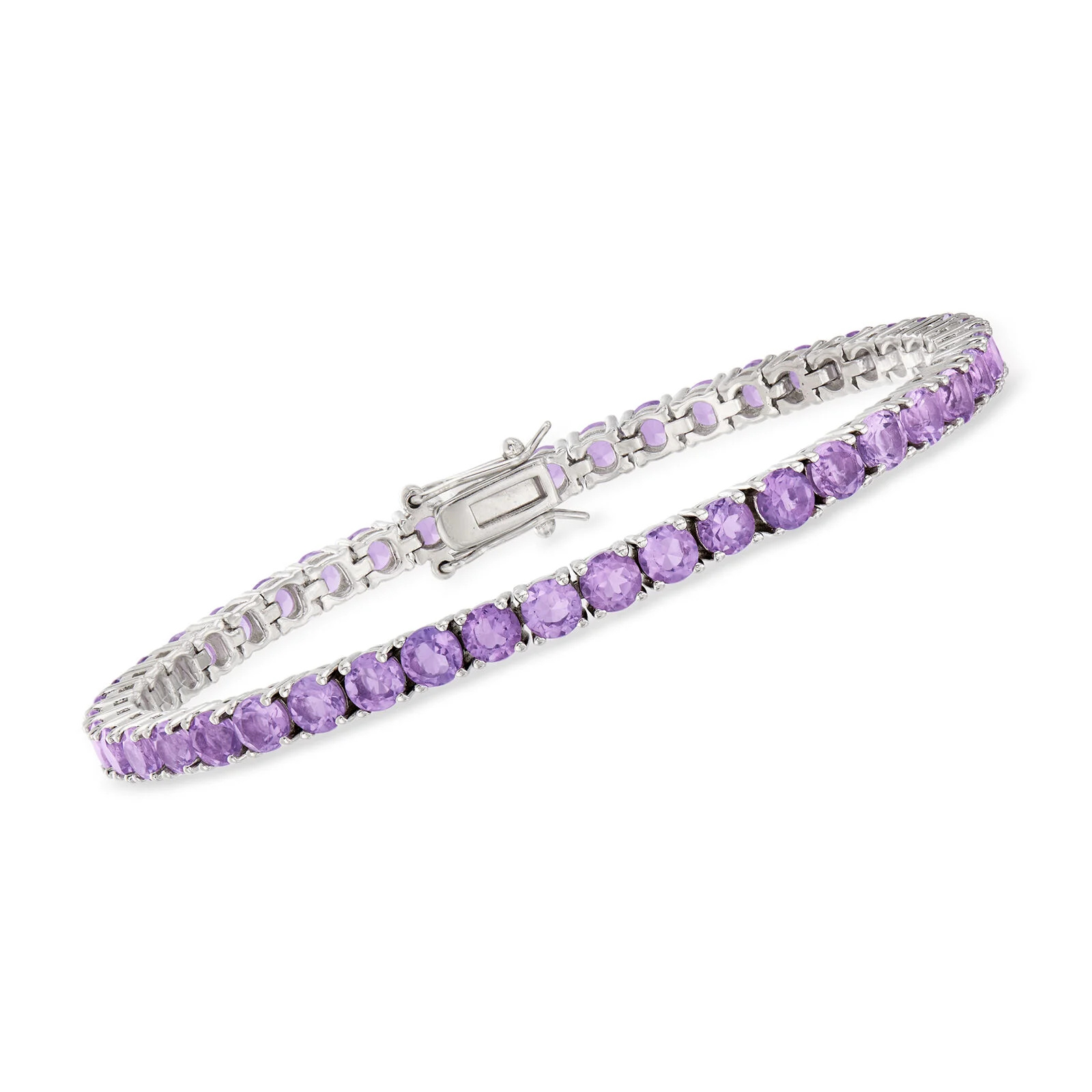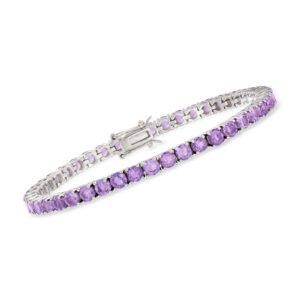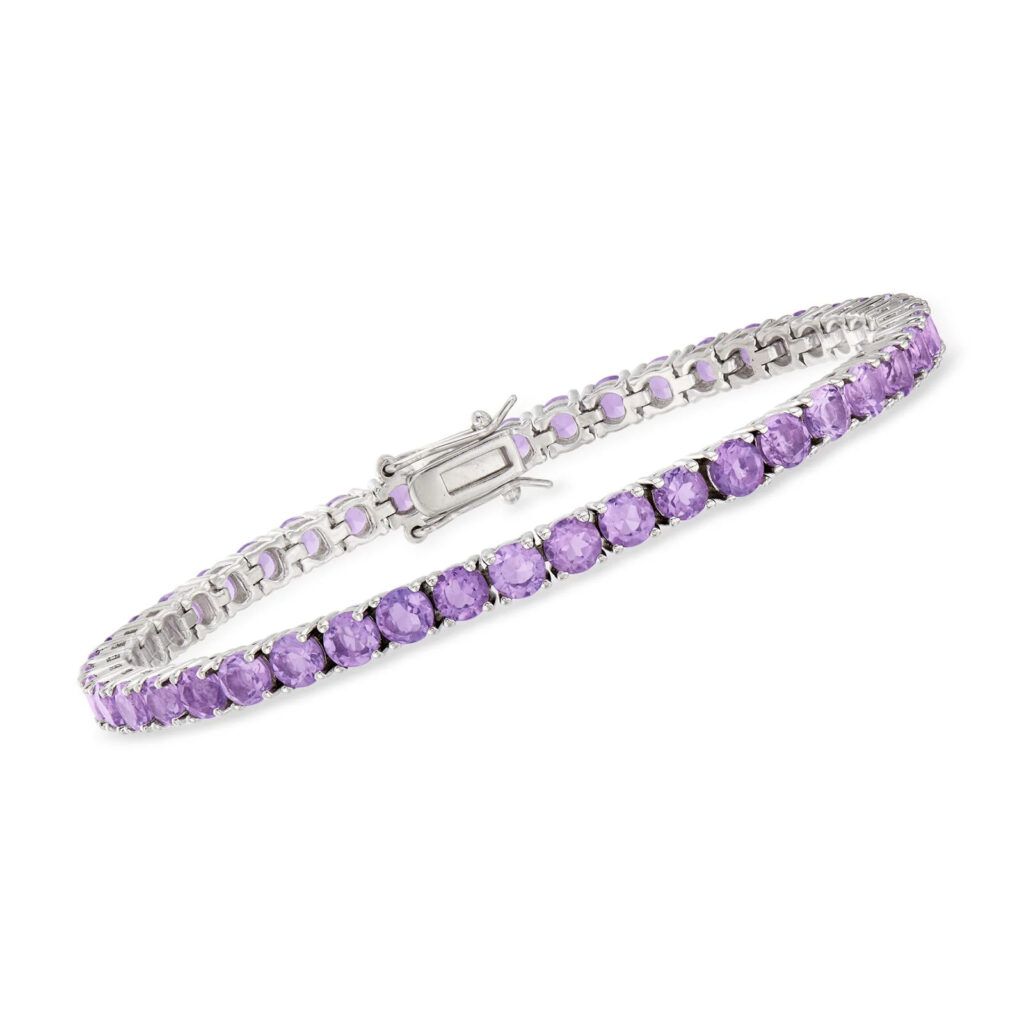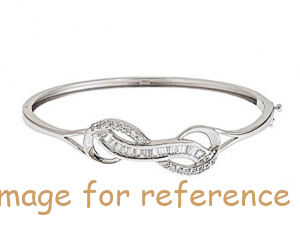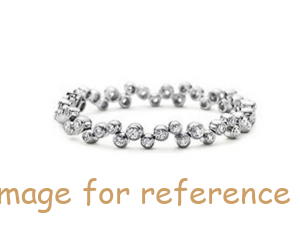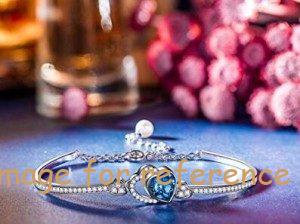The OEM price of Amethyst Tennis Bracelet in Sterling Silver in China
OEM/ODM ผู้ผลิตเครื่องประดับออกแบบที่กำหนดเองเครื่องประดับของคุณเอง
เริ่มต้นกันเถอะ : mo@kingjy.com
Decoding the OEM Price of an Amethyst Tennis Bracelet in Sterling Silver in China: A Comprehensive Guide for Brands and Retailers
เชิงนามธรรม
The Amethyst Tennis Bracelet in Sterling Silver represents a perfect storm of contemporary jewelry trends: the enduring appeal of a classic tennis bracelet design, the vibrant and spiritual allure of amethyst, and the accessible luxury of sterling silver. สำหรับแบรนด์, ผู้ค้าปลีก, and startups looking to capitalize on this demand, sourcing from China through an OEM (ผู้ผลิตอุปกรณ์ดั้งเดิม) model offers a compelling path to market with competitive pricing and customizability. อย่างไรก็ตาม, the quoted price per piece is not a single number but the final output of a complex equation involving gemstone quality, น้ำหนักโลหะ, ความเข้มแรงงาน, and order logistics.
This in-depth white paper demystifies the cost structure of manufacturing a Sterling Silver Amethyst Tennis Bracelet in China. We will dissect every component that contributes to the final OEM price, from the volatile cost of raw materials to the nuanced expenses of craftsmanship and compliance. Beyond a simple breakdown, this guide provides a strategic framework for businesses to understand how their specific choices impact the bottom line, empowering them to make informed decisions, optimize their specifications for cost and market appeal, and ultimately select the right manufacturing partner for a successful and profitable product line.
ฉัน. การแนะนำ: The Allure of Amethyst and the OEM Advantage
The tennis bracelet, characterized by a continuous line of uniformly set gemstones, is a jewelry cabinet staple. Its name, famously inspired by Chris Evert’s habit of wearing her diamond bracelet on the tennis court, speaks to its design ethos: ปลอดภัย, สง่างาม, and flexible. When rendered in sterling silver and amethyst, this classic piece transforms into an accessible yet sophisticated item that appeals to a broad demographic, from fashion-forward youth to those drawn to amethyst’s reputed metaphysical properties of calm and clarity.
China has emerged as the global epicenter for jewelry manufacturing, not merely for its cost competitiveness but for its unparalleled ecosystem. This ecosystem includes:
-
Advanced Technological Integration: Widespread use of CAD/CAM, การหล่อที่แม่นยำ, และการเชื่อมด้วยเลเซอร์.
-
Artisanal Skill: A deep pool of skilled laborers specializing in stone-setting and finishing.
-
Supply Chain Clustering: Concentrated hubs in cities like Panyu (กว่างโจว), เซินเจิ้น, and Yiwu provide efficient access to metals, อัญมณี, and components.
-
Manufacturing Agility: The ability to handle orders from small, boutique batches to massive production runs.
The OEM model is the key that unlocks this ecosystem. It allows you, แบรนด์, to maintain control over design, การสร้างแบรนด์, and quality standards while leveraging the manufacturer’s expertise and economies of scale. The first and most critical question in this engagement is: “What will it cost?” The answer is multifaceted.
II. Deconstructing the Price: The Core Cost Components
The final FOB (Free On Board) price of a single Amethyst Tennis Bracelet can be broken down into five primary categories. Understanding each is crucial to analyzing a manufacturer’s quote.
1. The Gemstone: The Heart of the Cost and Aesthetic
อเมทิสต์, a variety of quartz, is a semi-precious stone, but its price varies dramatically based on quality. This is the single most significant variable in your bracelet’s cost.
อัน. ที่ “Four Cs” of Amethyst (Adapted):
-
สี: This is the most critical factor. The most valued color is a strong, deep purple with reddish or blueish secondary hues, มักเรียกว่า “Siberian” หรือ “Deep Russian” grade in the trade. Lighter, paler lilac or lavender shades (sometimes called “Rose de France”) are more abundant and less expensive. A consistent, saturated color across all stones in the bracelet is paramount and commands a premium.
-
ความชัดเจน: Amethyst is a Type II gemstone, meaning some inclusions are expected. อย่างไรก็ตาม, high-quality amethyst for jewelry should be “ทำความสะอาดตา” – no visible inclusions to the naked eye. Stones with visible clouds, รอยแตก, or heavy veiling will be significantly cheaper but will detract from the bracelet’s brilliance and perceived value.
-
ตัด: The cut determines the stone’s brilliance and symmetry. สำหรับสร้อยข้อมือเทนนิส, the stones must be uniformly cut to ensure a smooth, continuous line. The most common cuts are round brilliant and oval, but princess, เบาะ, and marquise are also options.
-
Precision vs. Commercial Cut: Precision-cut stones are cut to exact mathematical proportions to maximize light return. They are more expensive. Commercial cuts are mass-produced to retain weight and are adequate for many price-sensitive lines but lack the same sparkle.
-
-
น้ำหนักกะรัต (ขนาด): This refers to the weight of each individual stone. A standard tennis bracelet typically uses stones ranging from 2.5mm to 6mm in diameter.
-
Size-to-Price Nonlinearity: The price per carat does not increase linearly. Larger stones of high quality are rarer, so a 5mm amethyst will cost significantly more ต่อหิน than a 3mm one, even though the size difference may not seem drastic. A bracelet with 4mm stones will not be twice the price of one with 2mm stones; it will be more, due to both the higher per-stone cost and the fact that fewer larger stones are needed to cover the same wrist circumference.
-
ข. Calibrated vs. Non-Calibrated Stones:
-
Calibrated Stones: These are pre-cut to exact millimeter dimensions (เช่น, 4.0mm x 4.0mm). This is essential for the uniform look of a tennis bracelet and is the industry standard for this product. They carry a slight premium due to the extra labor involved in precise sizing.
-
Non-Calibrated Stones: These are sold by weight and have slight variations in dimensions. They are unsuitable for a high-quality tennis bracelet as they will not set evenly.
C. Treatment and Origin:
-
Heat Treatment: The vast majority of commercial amethyst is heat-treated to enhance its color. This is a permanent, stable, and universally accepted practice. It does not typically lower the value. Untreated, naturally deep-colored amethyst is exceptionally rare and expensive.
-
ต้นทาง: While Brazilian and Zambian amethyst are major sources, origin has less impact on the price of amethyst compared to gems like sapphire or emerald, unless it is a specifically marketed feature (เช่น, “Deep Zambian Amethyst”).
Cost Implication Summary: Specifying “4มม., deep purple, ทำความสะอาดตา, precision-round brilliant cut amethyst” will result in a gemstone cost that is 3x to 5x higher than a bracelet made with “3มม., light lavender, รวมเล็กน้อย, commercial cut amethyst.”
2. The Metal: เงินสเตอร์ลิง – More Than Just 92.5%
เงินสเตอร์ลิงเป็นโลหะผสมของ 92.5% เงินบริสุทธิ์และ 7.5% โลหะอื่น ๆ, มักจะเป็นทองแดง, เพื่อความแข็งแกร่ง.
อัน. Silver Weight and Purity:
-
The Cost of Weight: The single biggest metal cost driver is not the price of silver per gram (which is a global commodity), แต่ total weight of silver used in the bracelet. มีความละเอียดอ่อน, lightweight bracelet (เช่น, 5-7 กรัม) will have a low metal cost. A substantial, หนัก, more luxurious-feeling piece (เช่น, 10-15 กรัม) will cost significantly more.
-
Purity Assurance: Reputable manufacturers will use internationally certified 925 silver and provide assay testing. ถูกกว่า, sub-standard “925” alloy can contain lower silver content, leading to tarnishing and potential skin irritation.
ข. Construction and Design:
-
Setting Style: The metal structure that holds the stones is critical.
-
Single Setting: A common, cost-effective style where each stone is held by a minimal amount of metal.
-
การตั้งค่าช่อง: Stones are set between two walls of metal. This is a more complex, labor-intensive process that uses more metal and is therefore more expensive, but it offers a sleek, modern look and superior security.
-
การตั้งค่า bezel: A rim of metal completely surrounds each stone. This is the most secure and uses the most metal, making it the most expensive option.
-
-
Shank (โซ่) สไตล์: The back of the bracelet can be a lightweight, hollow box chain or a solid, durable rope or link chain. Solid chains use more metal and cost more but feel more premium and are less prone to bending.
C. การชุบ: โรเดียม
-
To prevent tarnishing and enhance whiteness and durability, almost all sterling silver jewelry is plated with rhodium, โลหะแพลตตินัม.
-
เรื่องความหนา: Standard plating is a few microns thick. A manufacturer might offer “Premium Heavy Rhodium Plating” for an additional cost, which significantly extends the life of the bright, tarnish-free finish.
3. กระบวนการผลิต: Where Craft Meets Cost
This is where the raw materials are transformed into a finished piece of jewelry.
-
การสร้างแบบจำลอง: Creating the master model, either by hand or via CAD/CAM. Cost can be amortized over the production run. การออกแบบที่ซับซ้อนมีค่าใช้จ่ายมากขึ้น.
-
การหล่อ: Using the lost-wax casting process. Vacuum-assisted casting is standard for quality; cheaper centrifugal casting can lead to more porosity and defects.
-
การตั้งค่าหิน: This is the most labor-intensive part.
-
Automated Setting: For very simple, uniform settings, some automation is possible.
-
Hand-Setting: The industry standard for quality. Each stone is individually set by a skilled artisan. The complexity of the setting (เช่น, ง่าม, ช่อง, ฝาปิด) directly impacts the labor time and cost. A bracelet with 40 stones takes significantly longer to set than one with 25.
-
-
การขัดและเสร็จสิ้น: ชิ้นงานได้รับการขัดเงาให้มีความเงางามสูง. This can be done by tumbling machines for initial stages but requires hand-polishing for a perfect finish. Additional finishes like matte or sandblasted surfaces may incur a small extra charge.
4. เหนือศีรษะ, Profit, and Compliance
The manufacturer’s quoted price must cover their business operations.
-
Factory Overhead: เช่า, ไฟฟ้า, management salaries, equipment depreciation.
-
การควบคุมคุณภาพ (QC): A rigorous manufacturer will have a multi-stage QC process, inspecting stones before setting, metalwork after casting, and the final product. This reduces your risk but adds to their cost.
-
อัตรากำไร: The manufacturer’s legitimate profit, typically between 15-30%, depending on the order size and complexity.
-
Compliance Costs: Adherence to international standards (เช่น, เข้าถึง, CPSIA) for material safety, ethical labor audits (เช่น, SEDEX, บีเอสซีไอ), and environmental regulations adds to the operational cost but is non-negotiable for reputable partners.
5. Order Logistics and The “การประหยัดจากขนาด” Principle
This is where your business decisions most directly impact the unit price.
-
สั่งซื้อปริมาณ (MOQ): The Most Order Quantity is a critical lever. กำลังผลิต 500 bracelets is far more efficient per unit than producing 50. The setup costs (model making, เป็นต้น) are spread over more units, and labor becomes more efficient. A manufacturer’s price for an order of 1000 pieces can be 30-50% lower per piece than for an order of 100.
-
ระดับการปรับแต่ง: A standard, off-the-shelf design is cheapest. A fully custom-designed bracelet, with a unique clasp, specific setting, and branded elements, requires more R&D and setup time, increasing the cost.
-
การบรรจุหีบห่อ: Simple poly bags are negligible in cost. Custom-branded velvet boxes, บัตรความถูกต้อง, and packaging add $1 ถึง $10+ ต่อหน่วย.
-
เงื่อนไขการชำระเงิน: อัน 50% deposit is standard. Suppliers may offer a slightly better price for more favorable terms (เช่น, 30% เงินฝาก).
III. A Practical Price Analysis: Scenario-Based Tables
Let’s translate these factors into tangible numbers. The following tables provide estimated FOB Shenzhen prices for different quality tiers and order quantities. *บันทึก: These are estimates for mid-2024. Silver price is volatile.*
สถานการณ์ 1: The Budget-Conscious / Fashion Line
-
Target Market: แฟชั่นที่รวดเร็ว, Low-Price-Point E-commerce
-
รายละเอียด: 3mm amethyst, light color, slight inclusions, commercial cut. Lightweight silver (~6g), single prong setting, standard rhodium plating.
| สั่งซื้อปริมาณ | Estimated Price per Piece (โกง) |
|---|---|
| 100 ชิ้นส่วน | $18.00 – $25.00 |
| 500 ชิ้นส่วน | $14.00 – $19.00 |
| 1,000 ชิ้นส่วน | $11.50 – $16.00 |
สถานการณ์ 2: The Mid-Market / คอลเลกชันหลัก
-
Target Market: Mainstream Jewelry Brands, Gift Shops, Etsy Sellers
-
รายละเอียด: 4mm amethyst, medium-deep purple, ทำความสะอาดตา, good commercial cut. Medium weight silver (~9g), secure prong or simple channel setting, good rhodium plating.
| สั่งซื้อปริมาณ | Estimated Price per Piece (โกง) |
|---|---|
| 100 ชิ้นส่วน | $32.00 – $45.00 |
| 500 ชิ้นส่วน | $26.00 – $36.00 |
| 1,000 ชิ้นส่วน | $22.00 – $30.00 |
สถานการณ์ 3: The Premium / Designer Line
-
Target Market: High-End Silver Brands, Artisanal Jewelers
-
รายละเอียด: 5mm amethyst, ลึก “Siberian” สี, flawless clarity, precision cut. Heavyweight silver (~13g), complex channel or bezel setting, premium heavy rhodium plating, custom-designed clasp.
| สั่งซื้อปริมาณ | Estimated Price per Piece (โกง) |
|---|---|
| 100 ชิ้นส่วน | $65.00 – $95.00 |
| 500 ชิ้นส่วน | $55.00 – $80.00 |
| 1,000 ชิ้นส่วน | $48.00 – $70.00 |
IV. Navigating the Supplier Selection and Quotation Process
A low quote can be a red flag. Here’s how to ensure you are comparing apples to apples.
1. Request a Detailed Quotation Breakdown:
A professional supplier will provide a line-item quote, not just a single price. It should detail:
-
Gemstone cost (per stone or total)
-
Metal cost (based on weight and current silver price)
-
Labor cost (การตั้งค่า, การขัด)
-
Model/Tooling cost (ถ้ามี)
-
Overhead and Profit
-
ต้นทุนตัวอย่าง: เสมอ, always pay for a pre-production sample. This is your only true way to verify quality. A supplier unwilling to provide a sample should be avoided.
2. Ask the Right Questions:
-
“Can you provide a video of the sample under natural light?”
-
“What is the exact average weight in grams of the silver used?”
-
“What is the thickness of the rhodium plating?”
-
“What is your defect rate, and what is your policy for replacements?”
-
“Can I see your compliance certificates (เช่น, เพื่อความบริสุทธิ์ของโลหะ)?”
3. The Hidden Costs of a “ราคาถูก” ผู้จัดหา:
Choosing the lowest bidder often leads to:
-
Inconsistent Quality: Stones of varying color and clarity within the same bracelet.
-
Poor Durability: บาง, weak settings that lead to lost stones.
-
Rapid Tarnishing: Due to sub-standard silver alloy or thin plating.
-
Communication Breakdowns: Leading to delays and errors.
-
Ethical Risks: Potential involvement with questionable labor practices.
V. บทสรุป: Price is a Function of Value
The OEM price of an Amethyst Tennis Bracelet in Sterling Silver from China is a transparent and logical calculation, but it requires a deep and nuanced understanding of its components. There is no single “ขวา” ราคา; there is only the right price for your specific quality tier, ความซับซ้อนของการออกแบบ, and order volume.
The most successful brands do not simply seek the cheapest manufacturer. They seek a พันธมิตร who can provide the optimal balance of cost, คุณภาพ, ความน่าเชื่อถือ, and service. They understand that investing in a slightly higher per-unit cost from a reputable OEM can save thousands in returns, customer complaints, and brand reputation damage down the line.
By approaching the sourcing process with the knowledge contained in this guide, you can move beyond price-shopping and engage in strategic, value-based conversations with potential suppliers. You can confidently specify your requirements, analyze quotations critically, and make choices that will result in a beautiful, well-made product that your customers will love and that will build the long-term equity of your brand.

